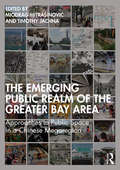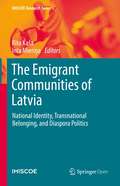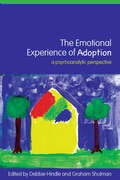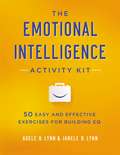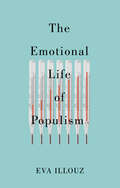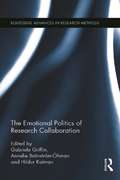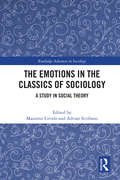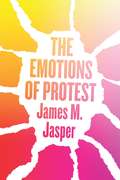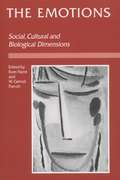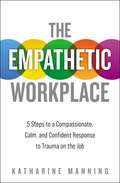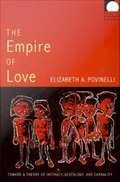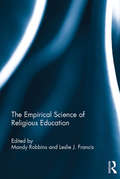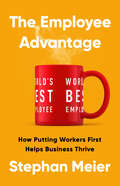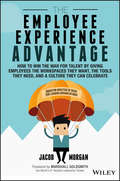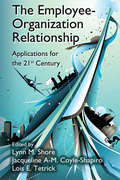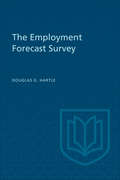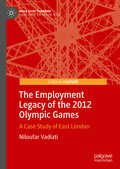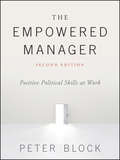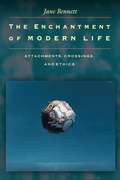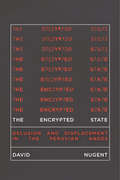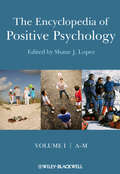- Table View
- List View
The Emerging Public Realm of the Greater Bay Area: Approaches to Public Space in a Chinese Megaregion
by Miodrag Mitrašinović; Timothy JachnaThrough illustrated case studies and conceptual re-framings, this volume showcases ongoing transformations in public space, and its relationship to the public realm more broadly in the world’s most populous urban megaregion—the Greater Bay Area of southeastern China—projected to reach eighty million inhabitants by the year 2025. This book assembles diverse approaches to interrogating the forms of public space and the public realm that are emerging in the context of this region’s rapid urban development in the last forty years, bringing together authors from urbanism, architecture, planning, sociology, anthropology and politics to examine innovative ways of framing and conceptualizing public space in/of the Greater Bay Area. The blend of authors’ first-hand practical experiences has created a unique cross-disciplinary book that employs public space to frame issues of planning, political control, social inclusion, participation, learning/education and appropriation in the production of everyday urbanism. In the context of the Greater Bay Area, such spaces and practices also present opportunities for reconfiguring design-driven urban practice beyond traditional interventions manifested by the design of physical objects and public amenities to the design of new social protocols, processes, infrastructures and capabilities. This is a captivating new dimension of urbanism and critical urban practice and will be of interest to academics, students and practitioners interested in urbanization in China.
The Emigrant Communities of Latvia: National Identity, Transnational Belonging, and Diaspora Politics (IMISCOE Research Series)
by Rita Kaša Inta MieriņaThis open access volume examines experiences of contemporary Latvian migrants, thereby focusing on reasons for emigration, processes of integration in their host countries, and – in the case of return migration - re-integration in their home country. In the context of European migration, the book describes the case of Latvia, which is interesting due to the multiple waves of excessive emigration, continuously high migration potential among European Union member states, and diverse migrant characteristics. It provides a fascinating insight into the social and psychological aspects linked to migration in a comparative context. The data in this volume is rich in providing individual level perspectives of contemporary Latvian migrants by addressing issues such as emigrants’ economic, social and cultural inclusion in the host country, ties with the home country and culture, interaction with public authorities both in the host and home country, political views, and perspectives on the permanent settlement in migration or return. Through topics such as assimilation of children, relationships between emigrants representing different emigration waves, the complex identities and attachments of minority emigrants, and the role of culture and media in identity formation and presentation, this book addresses topics that any contemporary emigrant community is faced with.
The Emoji Code: The Linguistics Behind Smiley Faces and Scaredy Cats
by Vyvyan EvansDrawing from disciplines as diverse as linguistics, cognitive science, psychology, and neuroscience, The Emoji Code explores how emojis are expanding communication and not ending it.For all the handwringing about the imminent death of written language, emoji—those happy faces and hearts—is not taking us backward to the dark ages of illiteracy. Every day 41.5 billion texts are sent by one quarter of the world, using 6 million emoji. Evans argues that these symbols enrich our ability to communicate and allow usto express our emotions and induce empathy—ultimately making us all better communicators.The Emoji Code charts the evolutionary origins of language, the social and cultural factors that govern its use, change, and development; as well as what it reveals about the human mind. In most communication, nonverbal cues are our emotional expression, signal our personality, and are our attitude toward our addressee. They provide the essential means of nuance and are essential to getting our ideas across. But in digital communication, these cues are missing, which can lead to miscommunication. The explosion of emojis in recent years has arisen precisely because it fulfills exactly these functions which are essential for communication but are otherwise absent in texts and emails. Evans persuasively argues that emoji add tone and an emotional voice and nuance, making us more effective communicators in the digital age.
The Emotional Experience of Adoption: A Psychoanalytic Perspective
by Debbie Hindle Graham ShulmanAdoption is an extremely complex and emotionally demanding process for all those involved. This book explores the emotional experience of adoption from a psychoanalytic perspective, and demonstrates how psychoanalytic understanding and treatment can contribute to thinking about and working with adopted children and their families. Drawing on psychoanalytic, attachment and child development theory, and detailed in-depth clinical case discussion, The Emotional Experience of Adoption explores issues such as: the emotional experience of children placed for adoption, and how this both shapes and is shaped by unconscious processes in the child’s inner world how psychoanalytic child psychotherapy can help as a distinctive source of understanding and as a treatment for children who are either in the process of being adopted or already adopted how such understanding can inform planning and decision making amongst professionals and carers. The Emotional Experience of Adoption explains and accounts for the emotional and psychological complexities involved for child, parents and professionals in adoption. It will be of interest and relevance to anyone involved at a personal level in the adoption process or professionals working in the fields of adoption, social work, child mental health, foster care and family support.
The Emotional Intelligence Activity Kit: 50 Easy and Effective Exercises for Building EQ
by Adele Lynn Janele LynnElevate emotional intelligence throughout your organization—and watch profitability, retention, and customer satisfaction soar!Know-it-all bosses, overcompetitive colleagues, and leaders who rarely leave their offices--common EQ problems such as these damage not just camaraderie, but also results. Because of this, managers are discovering now more than ever that emotional intelligence (EI)--knowing how to manage emotions, empathize, build relationships, and more--is a vital contributor to a company&’s success. But how does one go about persuading others to improve their EI?The Emotional Intelligence Activity Kit shows the way with 50 practical exercises to:Promote introspectionIncrease empathyImprove social skillsBoost influenceInspire purposeBring everyone on boardStudies have proven that emotional intelligence drives performance. But the problem has always been how to utilize this knowledge and inspire new ways of thinking among individuals.With The Emotional Intelligence Activity Kit, trainers, coaches, and organizational development professionals can now break through and trigger lasting EQ improvements to create thriving, successful organizations.
The Emotional Life of Populism: How Fear, Disgust, Resentment, and Love Undermine Democracy
by Eva IllouzThroughout the world, democracy is under assault from various populist movements and ideologies. And, throughout the world, the same enigma: why is it that political figures or governments, who have no qualms about aggravating social inequalities, enjoy the support of those whom their ideas and policies affect and hurt the most? To make sense of this enigma, the sociologist Eva Illouz argues that we must understand the crucial role that emotions play in our political life. Taking the case of Israel as her prime example, she shows that populist politics rest on four key emotions: fear, disgust, resentment, and love for one’s country. It is the combination of these four emotions and their relentless presence in the political arena that nourishes and underpins the rise and persistence of populism both in Israel and in many other countries around the world. This highly original perspective on the rise of populism will be of interest to anyone who wishes to understand the key political developments of our time.
The Emotional Politics of Racism: How Feelings Trump Facts in an Era of Colorblindness
by Paula IoanideWith stop-and-frisk laws, new immigration policies, and cuts to social welfare programs, majorities in the United States have increasingly supported intensified forms of punishment and marginalization against black, Latino, Arab and Muslim people in the United States, even as a majority of citizens claim to support "colorblindness" and racial equality. With this book, Paula Ioanide examines how emotion has prominently figured into these contemporary expressions of racial discrimination and violence. How U. S. publics dominantly feel about crime, terrorism, welfare, and immigration often seems to trump whatever facts and evidence say about these politicized matters. Though four case studies--the police brutality case of Abner Louima; the exposure of torture at Abu Ghraib; the demolition of New Orleans public housing units following Hurricane Katrina; and a proposed municipal ordinance to deny housing to undocumented immigrants in Escondido, CA--Ioanide shows how racial fears are perpetuated, and how these widespread fears have played a central role in justifying the expansion of our military and prison system and the ongoing divestment from social welfare. But Ioanide also argues that within each of these cases there is opportunity for new mobilizations, for ethical witnessing: we must also popularize desires for justice and increase people's receptivity to the testimonies of the oppressed by reorganizing embodied and unconscious structures of feeling.
The Emotional Politics of Research Collaboration (Routledge Advances in Research Methods #7)
by Gabriele Griffin Annelie Bränström-Öhman Hildur KalmanResearch collaboration in the form of networks, projects and centers has become one of the dominant modes of engaging in research, especially funded research, across all academic domains. However, there has been little research on the processes of such collaborations, particularly their affective dimensions. These, as this volume demonstrates and as researchers know well, are highly important, yet mostly not directly engaged with when scientists work together, even though they are experienced by everybody involved. This volume is the first to consider questions such as how the naming of projects impacts on their accompanying "affect-scapes," the policing or disciplining of emotions in research collaborations, their accompanying tensions and how these might be managed, and the challenges to trust between scientists that such collaborations present. Drawing on theories of affect and literature on collaboration, as well as on the contributors’ experiences of being involved in large-scale research projects, the volume also importantly deals directly with some of the key emotions that occur during research collaborations such as blame, elation, frustration, alienation and belonging, and suggests some ways in which one might engage productively with the affective dimensions of research collaboration.
The Emotional Self: A Sociocultural Exploration (Cultural Studies)
by Deborah Lupton`This addition to a growing number of texts which approach emotions and emotionality from a social constructionist perspective is well written, scholarly, accessible and interesting.... There is both breadth and depth to this work.' - Feminism and Psychology This broad-ranging and accessible book brings together social and cultural theory with original empirical research into the nature of the emotional self in contemporary western societies. The emphasis of the analysis is on the emotional self as a dynamic project that is continually shaped and reshaped via discourse, embodied sensations, memory, personal biography and interactions with others and objects. Using an interdisciplinary approach, Deborah Lupton draws on a number of sociocultural approaches that adopt a post-structuralist perspective. She strongly emphasizes language and discourse as they construct and express concepts of the self and the emotions, whilst also acknowledging the sensual, embodied and unconscious dimensions of emotional experience.
The Emotions in the Classics of Sociology: A Study in Social Theory (Routledge Advances in Sociology)
by Massimo CeruloThe Emotions in the Classics of Sociology stands as an innovative sociological research that introduces the study of emotions through a detailed examination of the theories and concepts of the classical authors of discipline. Sociology plays a crucial role emphasizing how much emotional expressions affect social dynamics, thus focusing on the ways in which subjects show (or decide to show) a specific emotional behaviour based on the social and historical context in which they act. This book focuses the attention on the individual emotions that are theorized and studied as forms of communication between subjects as well as magnifying glasses to understand the processes of change in the communities. This volume, therefore, guides the readers through an in-depth overview of the main turning points in the social theory of the classical authors of sociology highlighting the constant interaction between emotional, social and cultural elements. Thus, demonstrating how the attention of the emotional way of acting of the single subject was already present in the classics of the discipline. The book is suitable for an audience of undergraduate, postgraduate students and researchers in sociology, sociology of emotions, sociology of culture, social theory and other related fields.
The Emotions of Protest
by James M. JasperIn Donald Trump’s America, protesting has roared back into fashion. The Women’s March, held the day after Trump’s inauguration, may have been the largest in American history, and resonated around the world. Between Trump’s tweets and the march’s popularity, it is clear that displays of anger dominate American politics once again. There is an extensive body of research on protest, but the focus has mostly been on the calculating brain—a byproduct of structuralism and cognitive studies—and less on the feeling brain. James M. Jasper’s work changes that, as he pushes the boundaries of our present understanding of the social world. In The Emotions of Protest, Jasper lays out his argument, showing that it is impossible to separate cognition and emotion. At a minimum, he says, we cannot understand the Tea Party or Occupy Wall Street or pro- and anti-Trump rallies without first studying the fears and anger, moral outrage, and patterns of hate and love that their members feel. This is a book centered on protest, but Jasper also points toward broader paths of inquiry that have the power to transform the way social scientists picture social life and action. Through emotions, he says, we are embedded in a variety of environmental, bodily, social, moral, and temporal contexts, as we feel our way both consciously and unconsciously toward some things and away from others. Politics and collective action have always been a kind of laboratory for working out models of human action more generally, and emotions are no exception. Both hearts and minds rely on the same feelings racing through our central nervous systems. Protestors have emotions, like everyone else, but theirs are thinking hearts, not bleeding hearts. Brains can feel, and hearts can think.
The Emotions: Social, Cultural and Biological Dimensions (The\law And Public Policy Ser.)
by Professor Rom Harre W Gerrod ParrottThis fascinating book overviews the psychology of the emotions in its broadest sense, tracing historical, social, cultural and biological themes and analyses. The contributors - some of the leading figures in the field - produce a new theoretical synthesis by drawing together these strands. <p><p> From the standpoint of the function of the emotions in everyday life, the authors focus on: the discursive role played by the emotions in expressing judgements about, attitudes to and contrition for actions done by the self and others, and how certain emotions - such as guilt, shame, embarrassment, chagrin and regret - seem to play a role in social control; the variation and diversity in emotion, which provides scope for exploring how patterns of emotion contrast in different societies, across gender lines, at different historical times, and between children and adults; and the way in which the body is shaped and its functions influenced by culturally maintained patterns of emotion displays.
The Empathetic Workplace: 5 Steps to a Compassionate, Calm, and Confident Response to Trauma On the Job
by Katharine ManningThis critical resource gives managers, HR, and anyone who may come into contact with someone in trauma—including workplace violence, harassment, assault, illness, addiction, fraud, bankruptcy, and more—the tools they need to be prepared for what lies ahead.This book is crucial for every manager or HR representative who shouldn&’t just prepare to one day be faced with a report of a traumatic experience at work, but plan on it. This five-step method will help managers make survivors feel supported and understood. The Empathetic Workplace guides supervisors of any level through an understanding of how stories of trauma impact the brain of both the survivor and the listener, as well as the tools to handle the interaction appropriately, to help the listener, the organization, and most importantly, the survivor. The easy-to-follow LASER method outlined in these pages includes the following elements that all managers should know and understand:Listen-Controlling your own reaction, managing your body language, asking open-ended questions, hearing what is not being said, and winding down the speaker when the conversation becomes unproductive are essential elements in being a good listener.Acknowledge-Once someone shares a difficult personal story with you, it is important to acknowledge that gift. Share-You can help the speaker regain some measure of control by sharing information with him or her about what happened or what happens next, your personal or organizational values, and what you don&’t yet know but hope to learn.Empower-You can help the traumatized person by providing him or her with resources that are available to them through the company or outside groups. Return-The final step is to ensure that the traumatized person has a way to come back later when he or she cannot remember all that you said, thinks of more questions, or wishes for updates. The LASER technique can benefit all who are responsible for others, from top-tier managers at Fortune 500 companies to Residence Advisors in college dormitories.
The Empire of Love: Toward a Theory of Intimacy, Genealogy, and Carnality
by Elizabeth A. PovinelliIn The Empire of Love anthropologist Elizabeth A. Povinelli reflects on a set of ethical and normative claims about the governance of love, sociality, and the body that circulates in liberal settler colonies such as the United States and Australia. She boldly theorizes intimate relations as pivotal sites where liberal logics and aspirations absorbed through settler imperialism are manifest, where discourses of self-sovereignty, social constraint, and value converge. For more than twenty years, Povinelli has traveled to the social worlds of indigenous men and women living at Belyuen, a small community in the Northern Territory of Australia. More recently she has moved across communities of alternative progressive queer movements in the United States, particularly those who identify as radical faeries. In this book she traces how liberal binary concepts of individual freedom and social constraint influence understandings of intimacy in these two worlds. At the same time, she describes alternative models of social relations within each group in order to highlight modes of intimacy that transcend a reductive choice between freedom and constraint. Shifting focus away from identities toward the social matrices out of which identities and divisions emerge, Povinelli offers a framework for thinking through such issues as what counts as sexuality and which forms of intimate social relations result in the distribution of rights, recognition, and resources, and which do not. In The Empire of Love Povinelli calls for, and begins to formulate, a politics of "thick life," a way of representing social life nuanced enough to meet the density and variation of actual social worlds.
The Empirical Science of Religious Education
by Mandy Robbins Leslie J. FrancisThe Empirical Science of Religious Education draws together a collection of innovative articles in the field of religious education which passed the editorial scrutiny of Professor Robert Jackson over the course of his impactful fourteen year career as editor of the British Journal of Religious Education. These articles have made an enormous contribution to the international literature establishing of the empirical science of religious education as a research field. The volume draws together, organises and illustrates the contours of this emerging field and is an essential compendium which covers work in: teacher education and teacher experience; student understanding, attitudes and values; varieties of religious schooling, and; worldview and life interpretation Organised into ten thematic sections the contributors cover the field comprehensively and bring with them an international and reflexive approach to their research. It is an essential resource for those practitioners and researchers who wish to access original and innovative research undertaken by way of ethnographic fieldwork, practitioner research, life-history approaches to research, psychological scales and measures, and large surveys. Particularly interested readers will be studying PGCE and masters level programmes in religious education, as well as qualified religious educators undertaking continuing professional development.
The Employable Sociologist: A Guide for Undergraduates
by Martha A. MartinezThis book addresses a gap in and outside academia: how to help Sociology undergraduates develop skills for career success while maintaining a sociologically rigorous approach. Matching sociological theories, methods, and knowledge with contemporary capitalistic managerial and work practices, it shows how sociology undergraduates are not only employable but have marketable advantages over graduates of other disciplines. A student following the program embodied in this book will actively nurture a strong sociological identity; create a job search plan integrating personal and disciplinary interests, values, and skills; design job application materials that provide the best fit for specific jobs and organizations; and launch a satisfying career path. Beyond an employment guide, it will facilitate the teaching of career development by Sociology faculty; increase students’ ongoing confidence in their potential; and provide a solid foundation for communicating the transformative power of Sociology to employers and managers in the government, business, and non-profit sectors.
The Employee Advantage: How Putting Workers First Helps Business Thrive
by Stephan Meier&“Move over, customer centricity. This book highlights that no company can afford to put employees second. With robust evidence and rich cases, Meier explains why leaders who fail to care about people do so at their own peril.&” ―Adam Grant, #1 New York Times–bestselling author of Think Again In an ever-shifting work landscape, leaders can no longer ignore their most overlooked stakeholders—their employees. In The Employee Advantage, behavioral economist Stephan Meier explains why organizations must value their employees as much as—if not more than—their customers: those that pivot toward an employee-centric model will be more profitable, innovative, and appealing to top talent. The good news? You don&’t need to start from scratch. The customer-centric tools that give you a competitive advantage can be repurposed to focus on employees. Through case studies of Fortune 500 companies like Costco, DHL, and Best Buy as well as smaller organizations, you will learn: Why employees care about more than just money when it comes to their jobs—the same way customers care about more than just price What two mindset shifts are essential to becoming an employee-centric workplace How improving your employee experience will benefit your business and your bottom line The future of work is human-centric. The companies that win in the marketplace will be those with the best employees. To get and stay ahead, businesses must embrace the employee advantage.
The Employee Experience Advantage: How to Win the War for Talent by Giving Employees the Workspaces they Want, the Tools they Need, and a Culture They Can Celebrate
by Marshall Goldsmith Jacob MorganResearch Shows Organizations That Focus on Employee Experience Far Outperform Those That Don't Recently a new type of organization has emerged, one that focuses on employee experiences as a way to drive innovation, increase customer satisfaction, find and hire the best people, make work more engaging, and improve overall performance. The Employee Experience Advantage is the first book of its kind to tackle this emerging topic that is becoming the #1 priority for business leaders around the world. Although everyone talks about employee experience nobody has really been able to explain concretely what it is and how to go about designing for it...until now. How can organizations truly create a place where employees want to show up to work versus need to show up to work? For decades the business world has focused on measuring employee engagement meanwhile global engagement scores remain at an all time low despite all the surveys and institutes that been springing up tackle this problem. Clearly something is not working. Employee engagement has become the short-term adrenaline shot that organizations turn to when they need to increase their engagement scores. Instead, we have to focus on designing employee experiences which is the long term organizational design that leads to engaged employees. This is the only long-term solution. Organizations have been stuck focusing on the cause instead of the effect. The cause is employee experience; the effect is an engaged workforce. Backed by an extensive research project that looked at over 150 studies and articles, featured extensive interviews with over 150 executives, and analyzed over 250 global organizations, this book clearly breaks down the three environments that make up every single employee experience at every organization around the world and how to design for them. These are the cultural, technological, and physical environments. This book explores the attributes that organizations need to focus on in each one of these environments to create COOL spaces, ACE technology, and a CELEBRATED culture. Featuring exclusive case studies, unique frameworks, and never before seen research, The Employee Experience Advantage guides readers on a journey of creating a place where people actually want to show up to work. Readers will learn: The trends shaping employee experience How to evaluate their own employee experience using the Employee Experience Score What the world's leading organizations are doing around employee experience How to design for technology, culture, and physical spaces The role people analytics place in employee experience Frameworks for how to actually create employee experiences The role of the gig economy The future of employee experience Nine types of organizations that focus on employee experience And much more! There is no question that engaged employees perform better, aspire higher, and achieve more, but you can't create employee engagement without designing employee experiences first. It's time to rethink your strategy and implement a real-world framework that focuses on how to create an organization where people want to show up to work. The Employee Experience Advantage shows you how to do just that.
The Employee-Organization Relationship: Applications for the 21st Century (Applied Psychology Series)
by Lois E. Tetrick Lynn M. Shore Jacqueline A-M. Coyle-Shapiro"Employee-organization relationship" is an overarching term that describes the relationship between the employee and the organization. It encompasses psychological contracts, perceived organizational support, and the employment relationship. Remarkable progress has been made in the last 30 years in the study of EOR. This volume, by a stellar list of international contributors, offers perspectives on EOR that will be of interest to scholars, practitioners and graduate students in IO psychology, business and human resource management.
The Employment Forecast Survey
by Douglas HartleIn this report Professor Hartle presents the findings of a series of investigations that have been carried out, partly under the auspices and partly with the co-operation, of the Canadian Department of Labour. The object of the investigations, the Employment Forecast Survey, was initiated by the Economics and Research Branch of that Department in 1946 to obtain information about the future levels and trends of employment in industry. The first phase of the investigation was carried out in 1953 by Professor William C. Hood assisted by Professor Hartle, and their report, dealing with the administration, policy, and technique of the Survey, constituted the foundation of the present study. In 1956-7 Professor Hartle conducted further studies of the Survey and its administration, analysing in particular the predictions which have been derived from the forecasts provided by individual establishments, and evaluating improvements which might have been made in the reliability both of the employer's forecasts and the Department's conclusions. The final phase of investigation carried out by Professor Hartle has been concerned mainly with an analysis of the forecasts of individual establishments. Professor Hartle's monograph, comprising as it does the findings of this whole series of studies, thus provides a comprehensive and detailed analysis of the Employment Forecast Survey. It is valuable for its comparison of the EFS with similar surveys conducted in the United States, the United Kingdom, and Germany. Canadian Studies in Economics, No. 14.
The Employment Legacy of the 2012 Olympic Games: A Case Study of East London (Mega Event Planning)
by Niloufar VadiatiThis book offers a detailed account of the employment promises made to local East Londoners when the Summer Olympic Games 2012 were awarded to London, as well as an examination of how those promises had morphed into the Olympic Labor market jamboree from which local communities were excluded.Regarding the global job market of London, this study provides a nuanced empirical view on how the world’s biggest mega event was experienced and endured in terms employment by its immediate hosts, in one of the UK’s poorest, most ethnically complex, and transient areas. The data has been collected through ethnographic observation and interviews with local residents, and expert interviews with the Olympic delivery professionals. Using Bourdieusian theory of contested capital, the findings provide an important bearing on the reproduction of inequality in the local labor markets of Olympic host cities.
The Empowered Manager: Positive Political Skills at Work (Jossey-bass Management Ser.)
by Peter BlockEmpowerment produces the conditions for high performance. Especially for middle managers and below. Empowered cultures attract and retain talent. They produce high achievement, high accountability and high commitment. The Empowered Manager uncovers a roadmap to creating a more accountable culture in today's fragmented and virtual world. Bestselling author Peter Block is a true visionary: author of the classic Flawless Consulting, his work is about empowerment, stewardship, chosen accountability, and reconciliation of community. In this book, he returns his eye toward management to renew our efforts to create a shift in the traditional hierarchy. Twenty years after the original book, Block talks of why it is so difficult to both open the door to empowerment and more importantly, have people walk through it. It is more important than ever to create a culture in which all members of an organization are treated as entrepreneurs, giving them ownership over their role and responsibilities. This is in the face of the reality that most employees want safety, not the adventure of empowerment. Peter enhances the first edition of the book by acknowledging employees wish for dependency. Their longing for the days when a job carried a promise of a future, and companies cared more about the product and the people, than about the money. This is written primarily for people in the middle. Good managers and employees who care more about doing good work and treating people right, than ambition and making it into the ruling class. The upper middle and below is where there is the greatest need for great management. Which builds on valuing strengths, and allowing talent the space to stretch and achieve. Almost independent of the power points of people at the top. This book shows you how a new approach to management empowers all employees at all levels, and culminates in better business outcomes for the entire organization. Help shape a culture of commitment Develop the political skills to negotiate successfully Take responsibility for your actions Learn to fail up, and face setbacks with courage If you feel controlled by bureaucracy, unrewarded for creativity, and from a distance, powerless to control your own destiny, this book is the breath of fresh air your career has been craving. Timeless tips from a master of business strategy alongside a framework for more effective management makes The Empowered Manager a must-read guide for anyone doing business today.
The Enchantment of Modern Life: Attachments, Crossings, and Ethics
by Jane BennettIt is a commonplace that the modern world cannot be experienced as enchanted--that the very concept of enchantment belongs to past ages of superstition. Jane Bennett challenges that view. She seeks to rehabilitate enchantment, showing not only how it is still possible to experience genuine wonder, but how such experience is crucial to motivating ethical behavior. A creative blend of political theory, philosophy, and literary studies, this book is a powerful and innovative contribution to an emerging interdisciplinary conversation about the deep connections between ethics, aesthetics, and politics. As Bennett describes it, enchantment is a sense of openness to the unusual, the captivating, and the disturbing in everyday life. She guides us through a wide and often surprising range of sources of enchantment, showing that we can still find enchantment in nature, for example, but also in such unexpected places as modern technology, advertising, and even bureaucracy. She then explains how everyday moments of enchantment can be cultivated to build an ethics of generosity, stimulating the emotional energy and honing the perceptual refinement necessary to follow moral codes. Throughout, Bennett draws on thinkers and writers as diverse as Kant, Schiller, Thoreau, Kafka, Marx, Weber, Adorno, and Deleuze. With its range and daring, The Enchantment of Modern Life is a provocative challenge to the centuries-old ''narrative of disenchantment,'' one that presents a new ''alter-tale'' that discloses our profound attachment to the human and nonhuman world.
The Encrypted State: Delusion and Displacement in the Peruvian Andes
by David NugentWhat happens when a seemingly rational state becomes paranoid and delusional? The Encrypted State engages in a close analysis of political disorder to shed new light on the concept of political stability. The book focuses on a crisis of rule in mid-20th-century Peru, a period when officials believed they had lost the ability to govern and communicated in secret code to protect themselves from imaginary subversives. The Encrypted State engages the notion of sacropolitics—the politics of mass group sacrifice—to make sense of state delusion. Nugent interrogates the forces that variously enable or disable organized political subjection, and the role of state structures in this process. Investigating the role of everyday cultural practices and how affect and imagination structure political affairs, Nugent provides a greater understanding of the conditions of state formation, and failure.
The Encyclopedia of Positive Psychology
by Shane J. LopezPositive psychology, the pursuit of understanding optimal human functioning, is reshaping the scholarly and public views of how we see the science of psychology. The Encyclopedia of Positive Psychology provides a comprehensive and accessible summary of this growing area of scholarship and practice. 288 specially commissioned entries written by 150 leading international researchers, educators, and practitioners in positive psychology covers topics of interest across all social sciences as well as business and industry the most current, extensive, and accessible treatment of the subject available topical primer clarifies basic constructs and processes associated with positive psychology will be useful to students, teachers, practitioners, businesspeople, and policy makers
